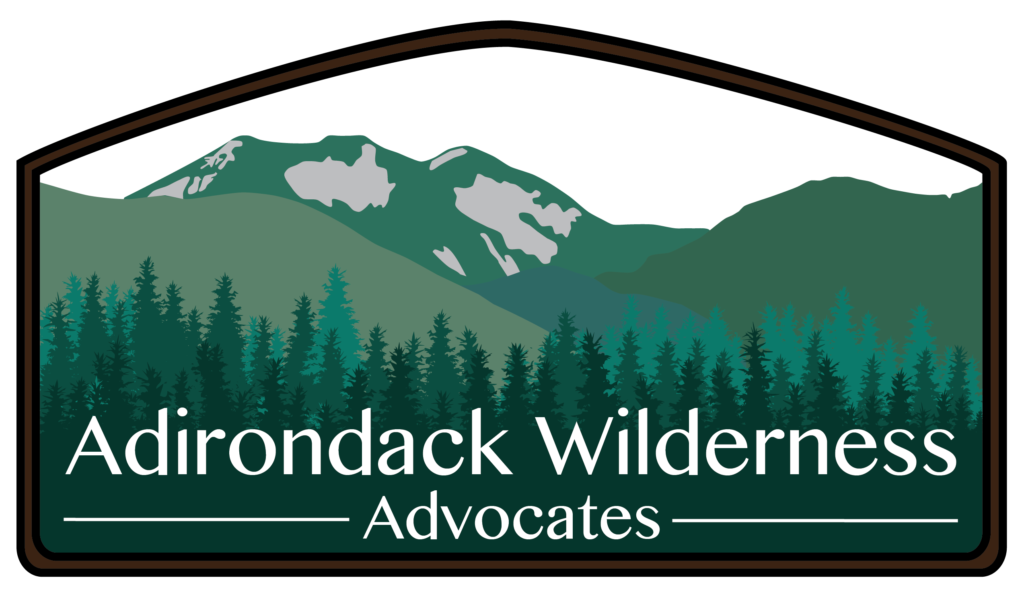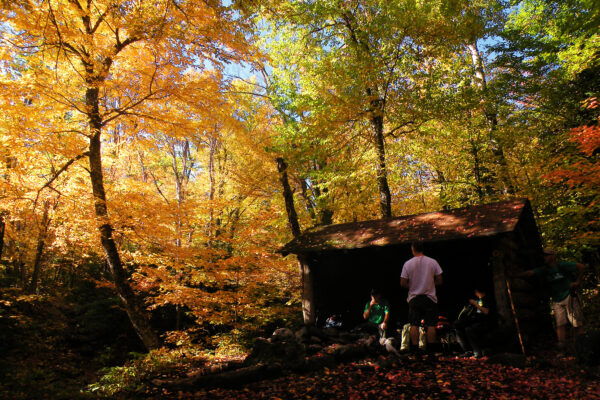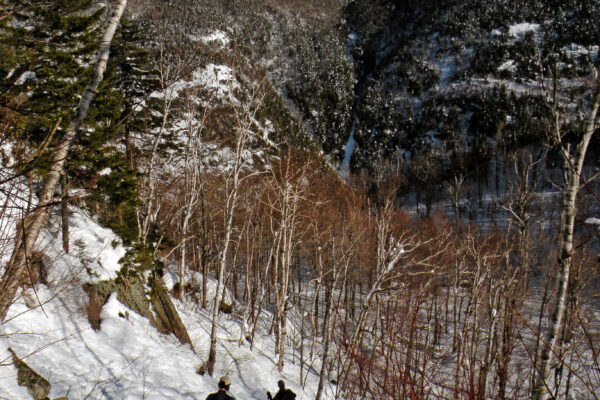The NYS Department of Environmental Conservation (DEC) recently announced plans to construct a 4-mile segment of a community connector snowmobile trail through lands classified as the Blue Ridge Wilderness. Adirondack Wilderness Advocates has reviewed the proposal and visited the lands along the route, and while we are generally satisfied that DEC’s plan does indeed remain along the periphery of the area, we do have some suggestions that would provide a better four-season trail experience, while more importantly doing more to protect the wilderness resource.
The proposed trail, called the Seventh Lake Mountain – Sargent Ponds Trail, is just one part of a longer “community connector” trail linking the Moose River Plains network with the hamlet of Long Lake in northern Hamilton County, eliminating the need to cross Raquette Lake. The primary intended use of the trail would be snowmobiles, but it has also been described as “multiple-use.” This presumably means bicycles as well as hiking.
A portion of the trail located in the Moose River Plains Wild Forest has already been constructed; plans for the final portion of the trail in the Sargent Ponds Wild Forest have yet to be released.
You can download and read DEC’s plan (it’s short, just 8 pages total) at the following link:
https://www.dec.ny.gov/lands/22608.html
Our Analysis of the Proposal
A protected Wilderness is generally an area that is managed as a motor-free environment, so to some people it will be disconcerting to discuss routing a snowmobile trail through the Blue Ridge Wilderness. AWA is very uncomfortable with the idea of routing the snowmobile trail through any portion of the Blue Ridge Wilderness, as this area was specifically designated to protect its motorless status. Even though the trail as currently planned will be located in the periphery of the unit, there will be aesthetic impacts that will affect the way wilderness users perceive the area. Furthermore, the trail will result in the loss of a natural soundscape for a larger area than is currently observed. We base this statement on the observation that snowmobile engine noises tend to travel longer distances than sounds from automobiles, and will therefore reach interior locations that are currently free of outside noises.
However, we acknowledge the Adirondack Park State Land Master Plan (SLMP) does permit such trail construction as long as it remains within 500 feet of a highway. Also, recent court decisions have upheld the state’s authority to use heavy equipment to construct these community connector trails, therefore there is little legal basis for opposing the trail outright.
The wilderness classification aside, this trail does have aspects that we like, particularly the fact that it is being restricted to the periphery of the area, very close to where motor vehicle traffic already exists. It also avoids the extensive wetlands that surround the Marion River, which effectively give few other options except to route the trail through a portion of the Blue Ridge Wilderness.
The new trail would also be a key link in the proposed Hamilton County Trail, a long-distance hiking trail roughly 160 miles long that would connect several communities throughout its namesake county. This route was first proposed in the Great South Woods regional planning project, and it is generally supported by AWA.
Naturally, as a wilderness advocacy organization, we do have some concerns with the proposed route, but we also have several ideas for improvement. DEC’s trail plan provides only one option to consider, with limited discussion of alternatives, but we think the plan can be adjusted to provide a better experience for riders while protecting the solitary and quiet nature of the Blue Ridge Wilderness.
Our primary concerns for protecting the wilderness are:
- Protecting the integrity of a stand of old growth red and white pine trees at South Inlet;
- Ensuring an adequate sound buffer between the snowmobile trail and the wilderness interior;
- Ensuring the integrity of the wilderness classification by asserting that the only non-conforming uses permitted on this new trail by the SLMP will be those related to snowmobiling, to the extent the trail crosses through wilderness-classified lands; and
- Expanding wilderness protections to adjacent areas near the southwestern boundary of the Blue Ridge Wilderness, with the goal of effecting a road closure in the vicinity of Mohegan Lake.
In terms of enhancing the four-season user experience of the new trail, we recommend these alterations to DEC’s proposal:
- Routing a portion of the trail through the Golden Beach Campground, to provide through-hikers with a direct link to the site’s amenities, as well as to provide campground users with a recreational trail featuring a direct link to Death Falls; and
- If bicycle use is intended for this trail, then this will require reclassifying the remaining portions of the trail corridor within the Blue Ridge Wilderness (no more than 103 acres, approximately) to intensive use and wild forest to permit the desired range of multiple uses.
The Old Growth Pines at South Inlet
 The scope of the current project extends from the South Inlet highway bridge on Route 28 to the Marion River Carry. At South Inlet, the NYS Department of Transportation (DOT) plans to replace the current span with a wider structure that also includes a separate space for snowmobiles and pedestrians, which may be completed by 2021. This new bridge is proposed as the westernmost point where the snowmobile trail begins its journey along the edge of the Blue Ridge Wilderness.
The scope of the current project extends from the South Inlet highway bridge on Route 28 to the Marion River Carry. At South Inlet, the NYS Department of Transportation (DOT) plans to replace the current span with a wider structure that also includes a separate space for snowmobiles and pedestrians, which may be completed by 2021. This new bridge is proposed as the westernmost point where the snowmobile trail begins its journey along the edge of the Blue Ridge Wilderness.
Immediately after crossing the new bridge, the trail as currently planned will climb a knoll on the south side of the highway — an area forested with old growth red and white pines. On our field check of the area, we found DEC’s pink project flagging, indicating the proposed route of the trail, leading straight through the grove. We assume that to accommodate the full width of the snowmobile trail, several of these large trees would need to be felled.
Red pines are particularly dominant at this site, and while such stands are common elsewhere in the Adirondacks, this is the only documented occurrence of this species in the Blue Ridge Wilderness. Therefore our preference would be not to disturb the site by constructing an 8-to-12-foot-wide trail with a graded surface through the middle of it.
We can only presume that DOT’s bridge replacement project will result in a minor highway realignment, which should provide the option to locate this 0.1-mile section of the snowmobile trail within the NY 28 travel corridor, making the disturbance to the old growth pine stand unnecessary. This is AWA’s preferred alternative for the westernmost 0.2 mile of the trail.
North or South of the Highway?
One of our main concerns is protecting the aesthetic qualities of the Blue Ridge Wilderness, including the quiet conditions that currently exist at interior locations such as Slim Pond. While the proposed trail would remain within 500 feet of the Route 28 highway corridor, we would expect that sounds from the new snowmobile traffic will carry a longer distance than the automobile sounds on the highway. This means that the current proposal, although it conforms to the SLMP, could degrade the perceived wildness and isolation of locations several miles away.
Two solutions for mitigating this sound impact immediately come to mind. One, obviously, is to increase the distance between the snowmobile trail and the places where wilderness visitors are most likely to be. And to the extent that the loudness of a snowmobile is a factor of speed, the second solution is to include built-in trail features that will help reduce speed, such as turns and highway crossings.
Citing the extensive wetlands along the Marion River as an obstacle, DEC proposes to route this entire section of the Seventh Lake Mountain – Sargent Ponds Trail on the south side of NY 28, all of which is part of the Blue Ridge Wilderness. Within this stretch of highway are two official DEC trailheads, as well as several informal trails used by hunters and bushwhackers for wilderness access.
In the current proposal, the new snowmobile trail will intersect DEC’s recently completed hiking trail to Slim Pond at the point where the trailhead register box now stands. This hiking trail represents the place within the scope of this project where most wilderness visitors will expect to find solitary and quiet conditions. Therefore separating these two trails — where the users of each route are most likely to have competing and incompatible expectations — should be a high priority.
From what we can tell by reviewing aerial images and topographic maps, the Marion River bogs are not an insurmountable obstacle to locating a portion of the snowmobile trail north of Route 28. Indeed, there appears to be ample room along the southerly edge of the Sargent Ponds Wild Forest where roughly 1.3 miles of trail could be located, from the Golden Beach Campground entrance to a potential highway crossing east of the Slim Pond trailhead. This would provide a greater degree of separation between the proposed new motorized use and the traditional non-motorized access to the south of the highway.
Another option might be to route the new trail within the highway corridor itself. A long section of NY 28 to the east of the campground has long sightlines and wide shoulders, thus suggesting the trail could follow the north edge of the road. Since earth-moving equipment will be used in the trail’s construction anyway, it makes sense to utilize the travel corridor whenever possible.
Indeed, we are requesting that DEC partner with DOT to determine the feasibility of using the travel corridor as much as possible for this entire section of the trail. We understand that there may be obstacles to make this alternative impractical, such as the presence of utility poles and the narrowness of some parts of the travel corridor, but in our view the current draft UMP amendment does not satisfactorily explore all available options.
Campground Connections
Elsewhere within the project area, DEC opted not to route the new trail through the nearby Golden Beach State Campground. In our view, such a facility is exactly the type of place where a multiple-use trail should go, and we are asking DEC to reconsider this element of their proposal.
In addition to snowmobiles, the new trail could also be a key link in the proposed Hamilton County Trail, a long-distance hiking trail identified in the 2015 Great South Woods regional planning project sponsored by Hamilton County and DEC. This 160-mile route would connect several communities from Arietta to Long Lake, and it faces the same need to find a land-based route around Raquette Lake as the snowmobile trail. Through-hikers would benefit from the presence of a developed campground on the direct route of the trail, and campground patrons would appreciate the convenient access to a recreational trail through the facility — especially one with a convenient link to Death Falls.
Therefore it is hard to understand how this wouldn’t be the preferred alternative. We are proposing that the new trail cross to the north side of Route 28 just north of Death Brook, at a point where the highway is straight and the sightlines are adequate for a safe crossing. The trail would then follow existing roads along the southern edge of the main campground area all the way to the main entrance, for a total distance of about 0.5 mile. To our knowledge, these roads aren’t used for any other purpose in the winter.
Multiple Uses and the State Land Master Plan
In its description of the snowmobile trail project, DEC refers to the route as a “Multiple-Use Trail Development,” without stating what other recreational uses are intended. While the SLMP does allow for snowmobile trails within the 500-foot peripheral zone of a wilderness, no other uses are mentioned, and therefore other recreational activities that would not otherwise be permitted in a wilderness would also not be permitted on this proposed trail.
Some people are concerned that as winter snow levels decline during the course of the twenty-first century, these graded community connector snowmobile trails will become tempting targets for ATV riders.
However, the “multiple use” that DEC is envisioning is most likely bicycles. The previous trail segment completed several years ago at Seventh Lake Mountain has been billed as a mountain bike route, and indeed it is conceivable that some bikers would appreciate a long-distance through-trail as much as snowmobile riders and hikers. Also, some campground patrons at Golden Beach would likely also desire access to a bicycle trail.
The wilderness classification will prevent DEC from opening the new section of the trail to bicycles, and AWA would object to any liberally interpretation the SLMP to include forms of access that are clearly not intended for wilderness areas. On the other hand, we are open to the possibility of reclassifying the peripheral zones to a less restrictive category, thus accommodating the trail while preserving the integrity of the adjacent wilderness. This would be the only acceptable solution to allow bicycles on any portion of the trail that passes through wilderness.
A Bigger Wilderness
Given the construction of as many as 4 miles of road-like trail through the Blue Ridge Wilderness, it seems reasonable to request that additional acreage be added elsewhere to offset the lost wilderness values resulting from this action. And if minor reclassifications are required to accommodate bicycle usage, then APA policy is clear that this would be an exceptional circumstance resulting in the loss of protection for the Forest Preserve. Only the reclassification of wild forest lands elsewhere would result in added protection of natural resources.
In this case, there are significant opportunities to expand the Blue Ridge Wilderness on its southern boundary, parts of which were drawn arbitrarily without regard to property lines or natural features. We have identified two potential additions that would add meaningful value to the wilderness, each for its own reasons.
One potential addition is Cellar Pond, a high-elevation tarn that is currently part of the Moose River Plains Wild Forest. The damp soils and steep mountainsides of the Cellar Pond basin make this a natural choice for a wilderness classification. We propose that an area roughly 2880 acres in size be added to the Blue Ridge Wilderness, including Cellar Pond, Cellar Mountain, and the headwaters of Payne Brook.
To the west of Cellar Pond, there is a vast tract of undeveloped backcountry that also meets the SLMP guidelines for a wilderness classification, in that there are no known non-conforming uses. This area, which includes most of Sumner Stream and extends as far west as the Red River, is largely trailless (with a few exceptions) and very remote; the easiest access is from the Moose River Plains Road on its southern boundary. There is one private inholding between Mohegan Lake and Bear Pond, but this is expected to be added to the Forest Preserve in 2022. By our analysis, 15,700 acres of this area currently meet wilderness guidelines, and are eminently suitable as a grand addition to the Blue Ridge Wilderness. The Sumner Stream addition is critical because the acquisition of the inholding will provide the opportunity to close 2.5 miles of motor vehicle road in a remote setting, thus offsetting the loss of natural resource protections caused by the creation of the multi-use trail. This was one of the the main reasons for nominating this parcel.
Combined, these two additions would add over 18,000 acres to the Blue Ridge Wilderness, representing an overall increase in size of 139%. Thus the twin goals of enhancing recreational access to the Forest Preserve and increasing natural resource protections could be accomplished simultaneously.
Conclusion
We would therefore like to partner with DEC to adjust the snowmobile trail proposal in a way that would still provide an enjoyable riding experience, while at the same time respecting the traditional and primitive forms of recreation that occur within the wilderness. These are not mutually exclusive goals, in our view.
By routing the middle section of the trail through the Golden Beach Campground and Sargent Ponds Wild Forest, we will be creating a more useful and enjoyable trail while simultaneously maximizing the effort to preserve the sense of isolation currently found at places like Slim Pond. In the two sections where we agree that rerouting the trail might not be practical, minor land reclassifications may be necessary to allow DEC to manage the new trail for the desired range of recreational uses, from snowmobiling to bicycling, if that is the intent. And by expanding the Blue Ridge Wilderness by as much as 139%, we will also be maximizing the protection for this large and remote area.
You can help protect the integrity of the Blue Ridge Wilderness by sending a comment letter to DEC.
AWA Maps









